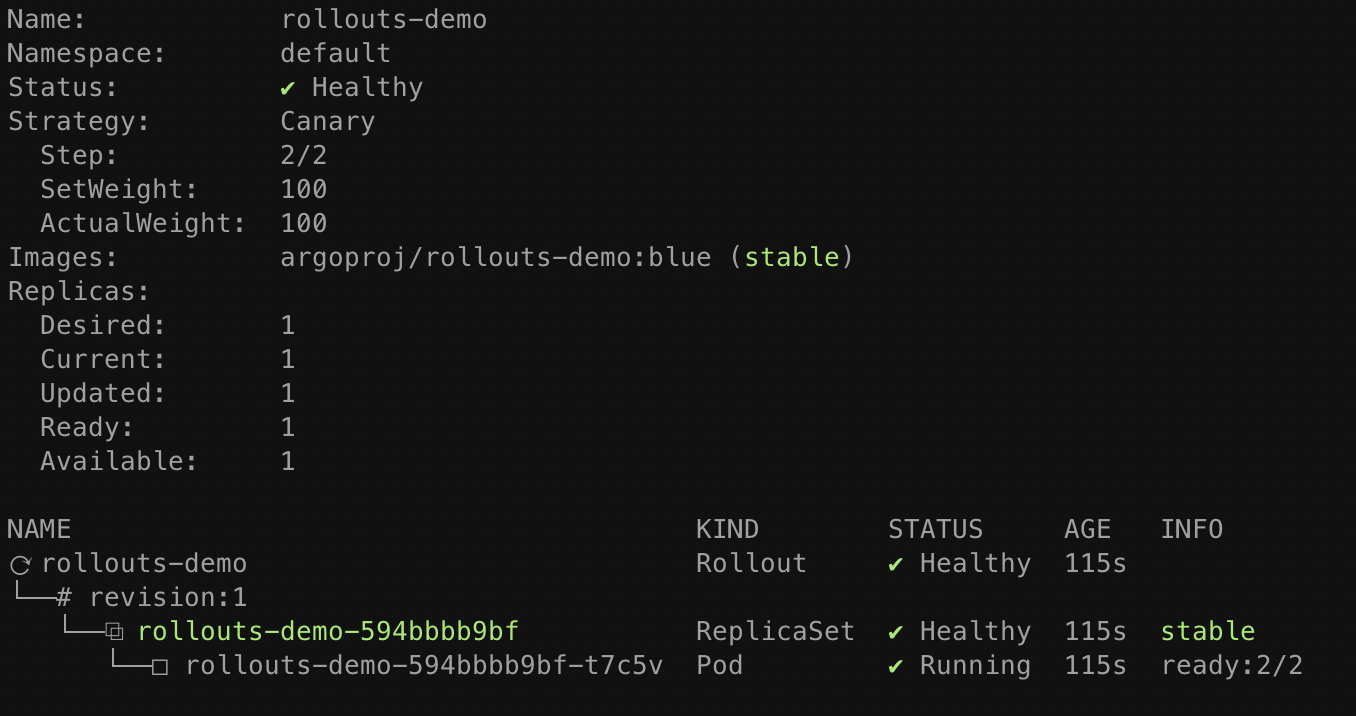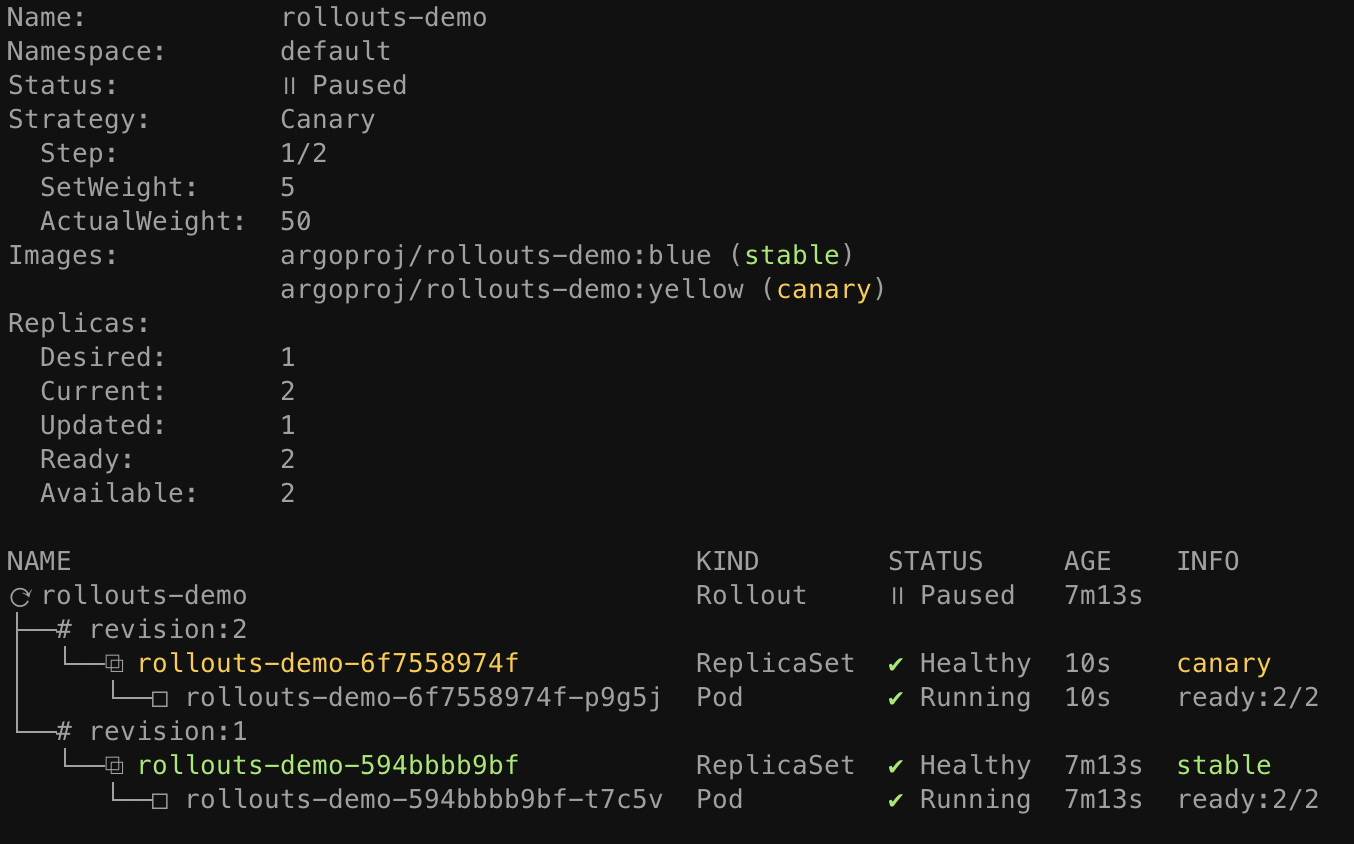Getting Started - Istio¶
This guide covers how Argo Rollouts integrates with the Istio Service Mesh for traffic shaping. This guide builds upon the concepts of the basic getting started guide.
Requirements¶
- Kubernetes cluster with Istio installed
Tip
See the environment setup guide for Istio on how to setup a local minikube environment with Istio
1. Deploy the Rollout, Services, Istio VirtualService, and Istio Gateway¶
When Istio is used as the traffic router, the Rollout canary strategy must define the following mandatory fields:
apiVersion: argoproj.io/v1alpha1
kind: Rollout
metadata:
name: rollouts-demo
spec:
strategy:
canary:
# Reference to a Service which the controller updates to point to the canary ReplicaSet
canaryService: rollouts-demo-canary
# Reference to a Service which the controller updates to point to the stable ReplicaSet
stableService: rollouts-demo-stable
trafficRouting:
istio:
virtualServices:
# One or more virtualServices can be configured
# Reference to a VirtualService which the controller updates with canary weights
- name: rollouts-demo-vsvc1
# Optional if there is a single HTTP route in the VirtualService, otherwise required
routes:
- http-primary
# Optional if there is a single HTTPS/TLS route in the VirtualService, otherwise required
tlsRoutes:
# Below fields are optional but if defined, they should match exactly with at least one of the TLS route match rules in your VirtualService
- port: 443 # Only required if you want to match any rule in your VirtualService which contains this port
# Only required if you want to match any rule in your VirtualService which contain all these SNI hosts
sniHosts:
- reviews.bookinfo.com
- localhost
- name: rollouts-demo-vsvc2
# Optional if there is a single HTTP route in the VirtualService, otherwise required
routes:
- http-secondary
# Optional if there is a single HTTPS/TLS route in the VirtualService, otherwise required
tlsRoutes:
# Below fields are optional but if defined, they should match exactly with at least one of the TLS route match rules in your VirtualService
- port: 443 # Only required if you want to match any rule in your VirtualService which contains this port
# Only required if you want to match any rule in your VirtualService which contain all these SNI hosts
sniHosts:
- reviews.bookinfo.com
- localhost
tcpRoutes:
# Below fields are optional but if defined, they should match exactly with at least one of the TCP route match rules in your VirtualService
- port: 8020 # Only required if you want to match any rule in your VirtualService which contains this port
The VirtualService and route referenced in either trafficRouting.istio.virtualService or
trafficRouting.istio.virtualServices. trafficRouting.istio.virtualServices helps in adding
one or more virtualServices unlike trafficRouting.istio.virtualService where only single virtualService can be added.
This is required to have either HTTP, TLS, TCP or a mixed route specs that splits between the stable and the canary
services referenced in the rollout. If the route is HTTPS/TLS, we can match it based on the
given port number and/or SNI hosts. Note that both of them are optional and only needed if you
want to match any rule in your VirtualService which contains these.
In this guide, the two services are: rollouts-demo-stable and rollouts-demo-canary respectively.
The weights for these two services should initially be set to 100% on the stable service and 0% on
the canary service. During an update, these values will get modified by the controller.
If there are multiple VirtualService then weight values for stable and canary service of each VirtualService
will be modified by the controller simultaneously.
Note that since we have both the HTTP and HTTPS routes in our rollout spec and they match the VirtualService specs, weights will get modified for both these routes.
apiVersion: networking.istio.io/v1alpha3
kind: VirtualService
metadata:
name: rollouts-demo-vsvc1
spec:
gateways:
- rollouts-demo-gateway
hosts:
- rollouts-demo-vsvc1.local
http:
- name: http-primary # Should match rollout.spec.strategy.canary.trafficRouting.istio.virtualServices.routes
route:
- destination:
host: rollouts-demo-stable # Should match rollout.spec.strategy.canary.stableService
port:
number: 15372
weight: 100
- destination:
host: rollouts-demo-canary # Should match rollout.spec.strategy.canary.canaryService
port:
number: 15372
weight: 0
tls:
- match:
- port: 443 # Should match the port number of the route defined in rollout.spec.strategy.canary.trafficRouting.istio.virtualServices.tlsRoutes
sniHosts: # Should match all the SNI hosts of the route defined in rollout.spec.strategy.canary.trafficRouting.istio.virtualServices.tlsRoutes
- reviews.bookinfo.com
- localhost
route:
- destination:
host: rollouts-demo-stable # Should match rollout.spec.strategy.canary.stableService
weight: 100
- destination:
host: rollouts-demo-canary # Should match rollout.spec.strategy.canary.canaryService
weight: 0
tcp:
- match:
- port: 8020 # Should match the port number of the route defined in rollout.spec.strategy.canary.trafficRouting.istio.virtualServices.tcpRoutes
route:
- destination:
host: rollouts-demo-stable # Should match rollout.spec.strategy.canary.stableService
weight: 100
- destination:
host: rollouts-demo-canary # Should match rollout.spec.strategy.canary.canaryService
weight: 0
apiVersion: networking.istio.io/v1alpha3
kind: VirtualService
metadata:
name: rollouts-demo-vsvc2
spec:
gateways:
- rollouts-demo-gateway
hosts:
- rollouts-demo-vsvc2.local
http:
- name: http-secondary # Should match rollout.spec.strategy.canary.trafficRouting.istio.virtualServices.routes
route:
- destination:
host: rollouts-demo-stable # Should match rollout.spec.strategy.canary.stableService
port:
number: 15373
weight: 100
- destination:
host: rollouts-demo-canary # Should match rollout.spec.strategy.canary.canaryService
port:
number: 15373
weight: 0
tls:
- match:
- port: 443 # Should match the port number of the route defined in rollout.spec.strategy.canary.trafficRouting.istio.virtualServices.tlsRoutes
sniHosts: # Should match all the SNI hosts of the route defined in rollout.spec.strategy.canary.trafficRouting.istio.virtualServices.tlsRoutes
- reviews.bookinfo.com
route:
- destination:
host: rollouts-demo-stable # Should match rollout.spec.strategy.canary.stableService
weight: 100
- destination:
host: rollouts-demo-canary # Should match rollout.spec.strategy.canary.canaryService
weight: 0
tcp:
- match:
- port: 8020 # Should match the port number of the route defined in rollout.spec.strategy.canary.trafficRouting.istio.virtualServices.tcpRoutes
route:
- destination:
host: rollouts-demo-stable # Should match rollout.spec.strategy.canary.stableService
weight: 100
- destination:
host: rollouts-demo-canary # Should match rollout.spec.strategy.canary.canaryService
weight: 0
Run the following commands to deploy:
- A Rollout
- Two Services (stable and canary)
- One or more Istio VirtualServices
- An Istio Gateway
kubectl apply -f https://raw.githubusercontent.com/argoproj/argo-rollouts/master/docs/getting-started/istio/rollout.yaml
kubectl apply -f https://raw.githubusercontent.com/argoproj/argo-rollouts/master/docs/getting-started/istio/services.yaml
kubectl apply -f https://raw.githubusercontent.com/argoproj/argo-rollouts/master/docs/getting-started/istio/multipleVirtualsvc.yaml
kubectl apply -f https://raw.githubusercontent.com/argoproj/argo-rollouts/master/docs/getting-started/istio/gateway.yaml
After applying the manifests you should see the following rollout, services, virtualservices, and gateway resources in the cluster:
$ kubectl get ro
NAME DESIRED CURRENT UP-TO-DATE AVAILABLE
rollouts-demo 1 1 1 1
$ kubectl get svc
NAME TYPE CLUSTER-IP EXTERNAL-IP PORT(S) AGE
rollouts-demo-canary ClusterIP 10.103.146.137 <none> 80/TCP 37s
rollouts-demo-stable ClusterIP 10.101.158.227 <none> 80/TCP 37s
$ kubectl get virtualservice
NAME GATEWAYS HOSTS AGE
rollouts-demo-vsvc1 [rollouts-demo-gateway] [rollouts-demo-vsvc1.local] 54s
rollouts-demo-vsvc2 [rollouts-demo-gateway] [rollouts-demo-vsvc2.local] 54s
$ kubectl get gateway
NAME AGE
rollouts-demo-gateway 71s
kubectl argo rollouts get rollout rollouts-demo

2. Perform an update¶
Update the rollout by changing the image, and wait for it to reach the paused state.
kubectl argo rollouts set image rollouts-demo rollouts-demo=argoproj/rollouts-demo:yellow
kubectl argo rollouts get rollout rollouts-demo

At this point, both the canary and stable version of the Rollout are running, with 5% of the traffic directed to the canary. To understand how this works, inspect the VirtualService which the Rollout was referencing. When looking at both the VirtualService, we see that the route destination weights have been modified by the controller to reflect the current weight of the canary.
apiVersion: networking.istio.io/v1beta1
kind: VirtualService
metadata:
name: rollouts-demo-vsvc1
namespace: default
spec:
gateways:
- rollouts-demo-gateway
hosts:
- rollouts-demo-vsvc1.local
http:
- name: http-primary
route:
- destination:
host: rollouts-demo-stable
port:
number: 15372
weight: 95
- destination:
host: rollouts-demo-canary
port:
number: 15372
weight: 5
tls:
- match:
- port: 443
sniHosts:
- reviews.bookinfo.com
- localhost
route:
- destination:
host: rollouts-demo-stable
weight: 95
- destination:
host: rollouts-demo-canary
weight: 5
tcp:
- match:
- port: 8020
route:
- destination:
host: rollouts-demo-stable
weight: 95
- destination:
host: rollouts-demo-canary
weight: 5
apiVersion: networking.istio.io/v1beta1
kind: VirtualService
metadata:
name: rollouts-demo-vsvc2
namespace: default
spec:
gateways:
- rollouts-demo-gateway
hosts:
- rollouts-demo-vsvc2.local
http:
- name: http-primary
route:
- destination:
host: rollouts-demo-stable
port:
number: 15373
weight: 95
- destination:
host: rollouts-demo-canary
port:
number: 15373
weight: 5
tls:
- match:
- port: 443
sniHosts:
- reviews.bookinfo.com
route:
- destination:
host: rollouts-demo-stable
weight: 95
- destination:
host: rollouts-demo-canary
weight: 5
tcp:
- match:
- port: 8020
route:
- destination:
host: rollouts-demo-stable
weight: 95
- destination:
host: rollouts-demo-canary
weight: 5
As the Rollout progresses through steps, the HTTP, TLS, and/or TCP route(s) destination weights will be
adjusted to match the current setWeight of the steps.